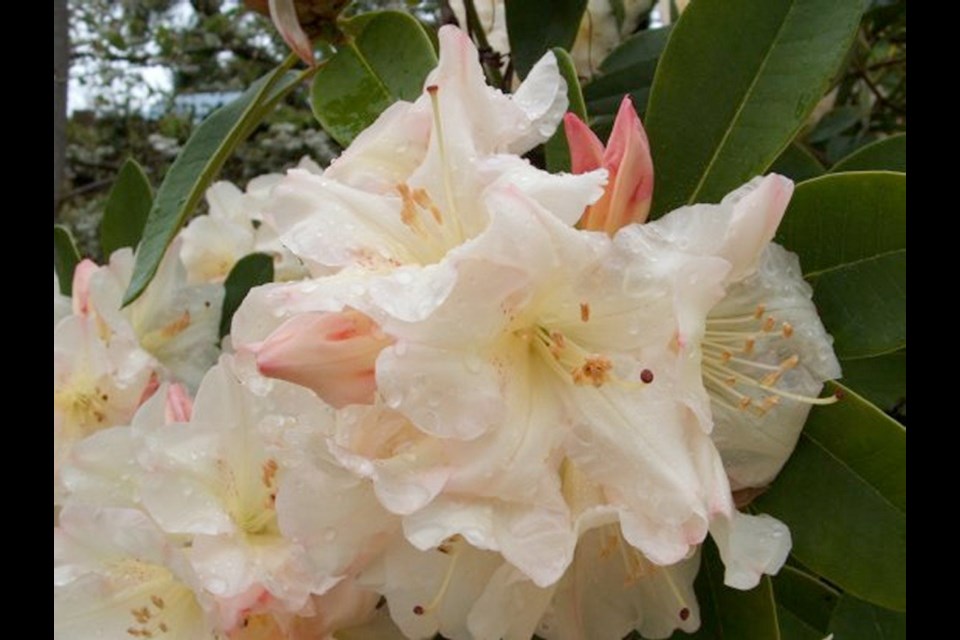Walking into a restaurant with friends last week, for a visit over breakfast, we stopped to admire the rhododendrons beginning to flower outside the doorway. These exuberant early bloomers are a sight to gladden winter-weary hearts and a sign that a long winter is near its end.
The earliest rhododendron I have is ‘Shamrock,’ a broad, low-growing (45 cm), bushy shrub with chartreuse-yellow blooms in March. As its name might suggest, the flower clusters usually begin to open around St. Patrick’s Day — today.
Each springtime, I celebrate the plant’s redemption from oblivion, when it became dangerously over-shadowed by an overbearing camellia nearby. Careful post-bloom pruning back and removal of the camellia’s lowest branches, together with generous spring mulching with compost, have returned Shamrock to pleasing form and full flowering.
Beware the pitfalls. Fresh greenery and spring flowers inspire and impel gardeners to choose new plants for their landscapes. In the midst of planting fervour, be aware of a few simple guidelines and also of easily made miscalculations.
• Plant size. Check labels carefully for the eventual dimensions of a shrub or tree, and be sure you have a location that allows for the required space.
• Prepare the soil over an area at least several times more broad than the pot width. Dig the site over-deeply, incorporating a handful of bone meal or rock phosphate and a generous layer of compost.
• Make sure the root ball in the pot is thoroughly moistened before unpotting and checking the roots. If they are tangled, loosen them out and shorten over-long ones. If the roots have grown into a solid mat, take a narrow slice off the bottom and sides to allow fresh roots to escape and grow.
• Settle most plants in the soil at the same depth they were in the pot. Check label directions on this first. Dig the hole, plant with free roots splayed out, partly fill the hole, and water well before adding more soil and tamping it down firmly around the plant.
• Spread a layer of compost over and around the plant.
Watch your back. Two years ago this spring, I was on my knees, holding a large, heavy, flattened boulder, intending to place it as a stepping pad into a garden bed. Twisting my torso to reach the precise placement I wanted was a big mistake. Resulting occasional back twinges still persist .
To avoid strain or injury to the back while gardening, don’t do what I did. Whether lifting, digging or weeding, keep the whole, aligned body — legs, hips, shoulders — directly facing the work at hand. Avoid twisting.
Bend at the hips, not the waist. Dig using arms and legs, not the back. Take breaks, and change tasks often rather than spend an entire afternoon on one project, however absorbing. Slowly, slowly I’m learning to appreciate the pleasures and benefits of garden job-hopping.
Garden events
Seedy in Duncan. Cowichan Green Community will host the 10th annual Duncan Seedy Sunday tomorrow, from 10 a.m. to 2 p.m. in the Cowichan Tribes Si’em Lelum Gymnasium, 5574 River Rd. Admission $2, CGC members and children under 13 free. cowichangreencommunity.org.
Rose meeting. The Mid Island Rose Society will meet on Monday, March 19, from 6 to 8 p.m. in the North Nanaimo Library on Hammond Bay Rd. Information at 250-390-2805.
Qualicum meeting. The Qualicum Beach Garden Club will meet on Tuesday, March 20, at 7:30 p.m. in the Q.B. Civic Centre on Jones Street. Margaret Moser will speak about hellebores and their care.
Helleborganza. Revel in hellebores and companion plants at Fraser’s Thimble Farm’s Helleborganza, daily from 9 a.m. to 4:30 p.m. through to March 31. Thousands of hellebores will be available for sale at the Salt Spring Island nursery. thimblefarms.com.
Soil testing invitation. The Victoria Compost Education Centre, together with Royal Roads University, is continuing the Healing City Soils project by inviting residents of Colwood, Langford and View Royal to apply online to have their soil tested for heavy metals and to participate in followup best-gardening practices workshops. Find the application form at compost.bc.ca/healing-city-soils. Applications will be accepted to March 27.



